
|
Back to |
| The Front Page |
| The Game |
|
The downtown croquet party: Will this strategy work? |
|
by Bob Alman with thanks to Cathy Leske, Sally Harper, and John Riches Posted March 8, 2014
|
Every year on just about every continent, croquet players and fans put to the test their "good ideas" on how to attract more people--and especially younger ones--to our still largely undiscovered and distinctly elderly sport. In South Australia perhaps the best possible answer has emerged from an independent entrepreneur who has themed the "downtown" portion of a city-wide and month-long festival "The Royal Croquet Club," complete with a tiny croquet lawn in the middle, surrounded by activities that attract a youthful local after-work contingent. Thousands of visitors are trying out croquet on that lawn, and hundreds of them have been enlisted to have a go with a mallet in a slightly more serious venue--headquarters of the South Australia Croquet Association headquarters-- in a series of Friday evening events on their three lawns, hard by a clubhouse. If this is not the solution to a universal problem, surely it's a start in the right direction.
Adelaide Fringe began in 1960 as an alternative to the Adelaide Festival of the Arts and by 2014 has outstripped all initial expectations, spreading over hundreds of venues with over 1000 different shows encompassing music, comedy, theatre, visual arts and food and drink--and actively drawing an international contingent. People flock from all parts of Australia and overseas to enjoy the spectacle of the Adelaide Fringe. The whole city is teeming with tourists and locals alike.

|
| The site of the Royal Croquet Club in downtown Adelaide being prepared.. |
In 2013, Adelaide Fringe delivered a massive economic benefit to the State of South Australia amounting to $64.6 million--a 34% increase on 2012's figure. More than 300,000 tickets were sold and more than a million and half people attended. And the Fringe just keeps growing.
In 2014, as it happens, one of the largest downtown venues, right in the middle of Adelaide, is themed as a croquet lawn party, complete with Pimms and Heineken and numerous other sponsors, with a tiny croquet lawn in the middle, beyond a gate labeled ROYAL CROQUET CLUB. Croquet figures fifty feet high with mallets make the point unmistakably in Victoria Square, which is smaller in total area than a football field.
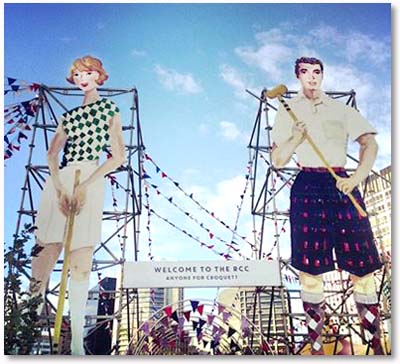
|
| ...later in the day, prepared to open for business... |
I asked Cathy Leske, Executive Director of South Australia Croquet Association, to explain croquet's place in the Fringe: She told me, "The Royal Croquet Club is an externally run licenced venue encompassing performance tents, bars and food outlets and a croquet lawn as the centrepiece, right in the heart of the city at Victoria Square and run by an Adelaide entrepreneur.
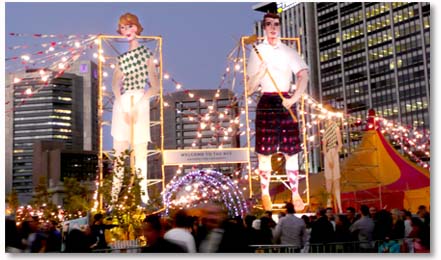
|
| ...and finally, at night, with the party in full swing. |
"We are sponsors of the croquet lawn at this Fringe venue, running from 14th February till 10 March. It's an extremely popular venue for patrons with white picket fencing, Pimms and lawn chairs, in true British style. We expect thousands of people to have a go at croquet during the Fringe. Our club members have been quick to take up the opportunity by manning the lawn every day and evening (it is open from Wednesdays to Sundays) and the gold coin entry to the croquet lawn [the Australian dollar] to play goes back to the club."
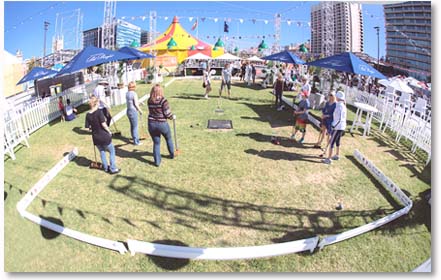
|
In downtown Victoria Square in 2014, many of the attendees are 20- and 30-somethings, just off work and looking to party nearby, beckoned by the lights, the music, nightly performances within the Club and giant croquet figures with croquet mallets marking the entrance. Beyond the gate of the Royal Croquet Club, attractive women are in view, being offered mallets, so eligible young men want to go in, too. In a trice, they all find out what croquet organizers discovered long ago: that croquet is the ultimate social sport. Just as it was in England's original croquet lawn parties in the 19th century, it's an ideal setting for meeting eligibles of the opposite sex, for flirting, for saucy talk lubricated with brew. Who knows what might eventuate? A date, perhaps! And then....
I asked SACA officers how they made this happen: They didn't--but they did negotiate terms and conditions, like all the other sponsors. The Royal Croquet Club theme has been done before--but this time, croquet organizers were prepared to make the most of it. As it happens, SACA is in the process of branding their public introductory event as Hammer Time. According to Cathy, "Croquet as a product has never been 'branded' as such here, so we decided that for us to engage with a new generation of the community and capture their interest it needed a unique, modern, all encompassing name that would immediately mean 'croquet' instead of the old 'come 'n try croquet program'. This is just part of our strategic plan."

|
So four sessions of Hammer Time at the SACA headquarters a mile from Victoria Square are planned to begin in mid-March, in the late afternoon, right after office hours. They'll carry on the "croquet lawn party" theme, but in a much more focused way, on fast and smooth regulation lawns at a three-court facility and clubhouse on Hutt Road.
The "four Fridays of fun" begin on March 14, and will include food and drink from the South Australia HQ clubhouse, along with Golf Croquet on regulation lawns, coached in a low-key manner by members of the state association. There is provision for these novices to become members in some category or another. One would hope that whatever category of membership they go into, the food and drink and peer-level flirting will still be allowed and encouraged as SACA goes all out in trying to re-invigorate a sport with a stodgy old-persons image. Surely the Hammer Time branding will help!
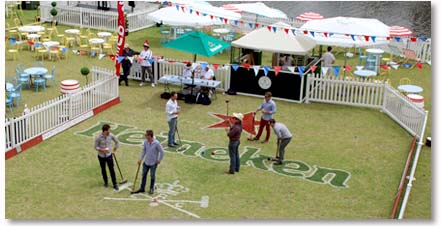
|
If that doesn't do the trick, there's another tactic in the works to lure the younger players before they're hired for downtown jobs. Sally Harper, SACA's Director of Sports Development, recently met with the sports development officers at Adelaide University about getting a university croquet club going, With her was an advanced ACA player, Greg Fletcher, who is enrolled at the university. Greg is about one one-quarter of Australia's youth croquet movement, the other three quarters being his teenage brothers, the eldest of whom, Robert, won the 2013 World Championship.

|
According to Sally, "Adelaide University offers great support and guidance to sporting groups. So there's no reason why we shouldn't try croquet there."
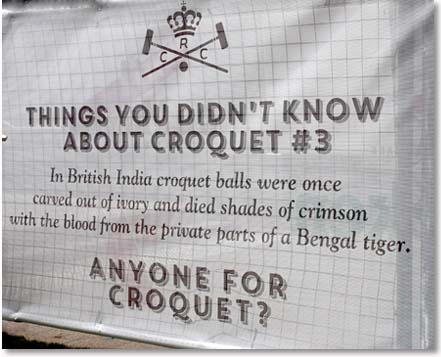
|
If all of this admirable planning and activity in South Australia constitutes the long-awaited breakthrough--the one measured in actual enrollments in club membership, and ultimately in state and national association memberships--we'll let you know.
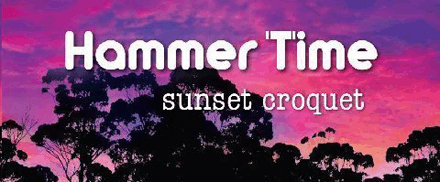
Hammer Time is four Fridays of fun for everyone!
|